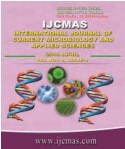


 National Academy of Agricultural Sciences (NAAS)
National Academy of Agricultural Sciences (NAAS)

|
PRINT ISSN : 2319-7692
Online ISSN : 2319-7706 Issues : 12 per year Publisher : Excellent Publishers Email : editorijcmas@gmail.com / submit@ijcmas.com Editor-in-chief: Dr.M.Prakash Index Copernicus ICV 2018: 95.39 NAAS RATING 2020: 5.38 |
A Quantitative Risk Assessment Model was constructed to estimate the probability that a serving of Chicken Briyani prepared in the catering units at Tamil nadu, India is contaminated with S. aureus. Existing data, predictive models and user input were used to define the input settings. The retail to table pathway was modeled as a series of nodes and associated pathogen events that included initial contamination of raw chicken at retail, growth during caterer transport, storage at catering establishments, thermal inactivation during cooking, post process contamination during serving (on the day consumption) and storage of leftover (consumption after overnight storage). The extent of S. aureus growth in each node (with exceptions) were assessed using Combase predictive models whereas thermal inactivation during cooking was quantified using simple mathematical calculations as there was no suitable inactivation model for S. aureus. The data, models and user inputs were entered into an Excel (Microsoft, Redmond, WA) spreadsheet. Modeling @RISK software (Palisade Corporation) was used to perform Monte Carlo simulation of ~10000 iterations. Results of exposure assessment and probability of illness revealed that 36.67% of the population consuming chicken briyani is at risk of staphylococcal food intoxication (at both node 5&6). In 95% of the cases, the probability of getting illness due to the consumption of S. aureus contaminated Chicken Briyani to at least one recipient is equal to or less than 0.99 or 99%.
 |
 |
 |
 |
 |